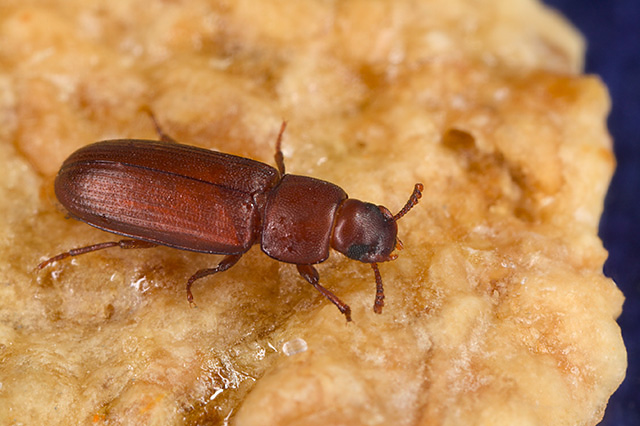- Tenebrioninae
image_width = 240px
image_caption =Red Flour Beetle ("Tribolium castaneum ":Triboliini )
regnum =Animal ia
phylum =Arthropod a
subphylum =Hexapoda
classis =Insect a
subclassis =Pterygota
infraclassis =Neoptera
superordo =Endopterygota
ordo = Coleoptera
superfamilia =Tenebrionoidea
familia =Tenebrionidae
subfamilia = Tenebrioninae
subfamilia_authority = Latreille, 1802
subdivision_ranks = Tribes
subdivision = Some 20, but see textTenebrioninae are a large
subfamily of thedarkling beetle s (Tenebrionidae), containing among others theflour beetle s.Many of these robust and usually mid-sized
beetle s haveelytra with some sort of corrugation on the upperside. They are usually colored blackish, dark brown or grey, and often have asatin y sheen; they are generally not glossy (some are outright matte) and few are metallic. The body is shaped like a medical capsule or like abullet ; the legs can be shortish and stout or long and spindly. They eat both fresh and decaying vegetation as well as vegetable produce, and several are commercially important pests e.g. offlour and othercereal products.Tenebrioninae are eaten by large
invertebrate s and smallvertebrate s, such asbird s,rodent s, andlizard s. Thelarva l stages of severalspecies are cultured asfeeder insect s for captiveinsectivore s, and include mealworms andmini mealworm s.Notable species
The
Mealworm Beetle ("Tenebrio molitor") is commonly used as food for terrestrialamniote s kept in terraria. Other "Tenebrio " and "Tribolium " species are also bred as animal food. TheRed Flour Beetle ("Tribolium castaneum ") is a populargenetics laboratory animal andmodel organism , especially in studies ofintragenomic conflict andpopulation ecology . Several species of "Tenebrio" and "Tribolium" (e.g.Confused Flour Beetle "T. confusum" or "T. destructor") and other genera (e.g. "Gnathocerus cornutus ") are pests ofcereal andflour silos and other storage facilities.ystematics
The Tenebrioninae are traditionally divided in some 20 tribes. The exact delimitation and validity of several of these is disputed however.
Molecular phylogenetic studies have yielded highly inconsistent results, perhaps due to any or all of hybridization,horizontal gene transfer by "Wolbachia " bacteria and insufficienttaxon sampling obfuscating the information contained inDNA sequence data.Angelini & Jockusch (2008)]In some treatments, the
Pimeliinae are included as yet another tribe. This may be correct, but as far as can be told they are a closely related but well distinct lineage ofTenebriodidae . TheCrypticini andPentaphyllini are sometimes placed here, but more commonly in theDiaperinae The tribes (and some notable genera) are:
Alphitobiini Reitter, 1917 (sometimes included in Triboliini)
* "Alphitobius " Stephens, 1829
* "Diaclina " Jacquelin du Val 1861Amarygmini
* "Amarygmus "
* "Plesiophthalmus "Biuini Blaptini Leach, 1815
* "Blaps " Fabricius, 1775
* "Gnaptor " Brullé 1832
* "Prosodes " Eschscholtz 1829
* "Tagona " Fischer von Waldheim 1822Bolitophagini Kirby, 1837
* "Atasthalomorpha "
* "Bolitoxenus "
* "Bolitophagus " Illiger 1798
* "Byrsax "
* "Eledona " Latreille 1796
* "Eledonoprius " Reitter 19116Dendarini Espanol, 1945 (sometimes included in Pedinini)
* "Bioplanes " Mulsant 1854
* "Dendarus " Latreille 1829
* "Heliopathes " Mulsant 1854
* "Isocerus " Latreille 1829
* "Micrositus " Mulsant & Rey 1854
* "Phylan " Dejean, 1821Heleini
* "
* "
* "
* "
* "
* "
* "
* "
* "
* "
* "
* "
* "
* "
* "
* "
* "
* "
* "
* "
* "
* "
* "

